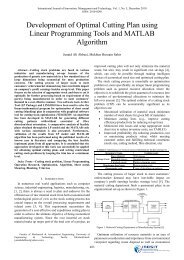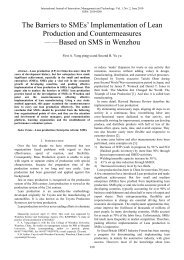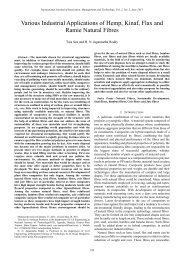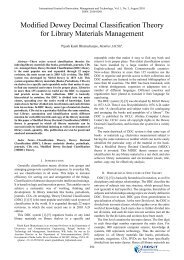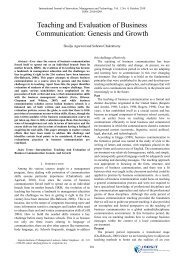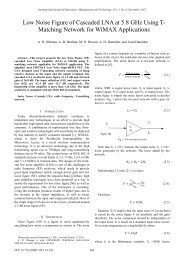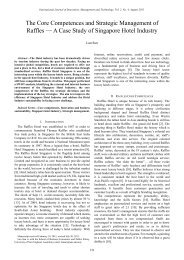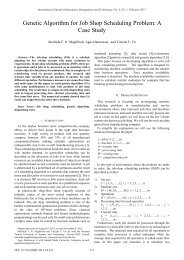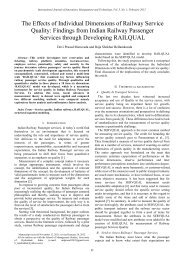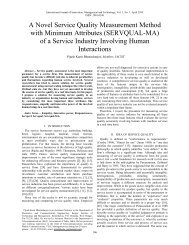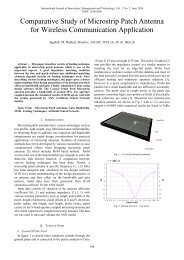Image Steganography Scheme using Chaos and Fractals with ... - ijimt
Image Steganography Scheme using Chaos and Fractals with ... - ijimt
Image Steganography Scheme using Chaos and Fractals with ... - ijimt
You also want an ePaper? Increase the reach of your titles
YUMPU automatically turns print PDFs into web optimized ePapers that Google loves.
International Journal of Innovation, Management <strong>and</strong> Technology, Vol. 3, No. 3, June 2012<br />
blue dotted curve is obtained by fixing W = db1<br />
while keep<br />
1<br />
changing W . We used the covariance of the cover image C<br />
2<br />
<strong>and</strong> the stego image S to measure the quality, namely a high<br />
covariance value implies a better quality. Generally speaking,<br />
the proposed method works well regardless to the selected<br />
wavelet. However, different wavelets do produce different<br />
performances <strong>and</strong> a periodic-like curve is observed when<br />
changing the wavelet function for W . The reason behind this<br />
1<br />
phenomenon is still unknown.<br />
Fig. 6. The influence of <strong>using</strong> different wavelet function.<br />
V. CONCLUSIONS<br />
A new steganographic method based on wavelet<br />
transforms <strong>and</strong> fractal images are proposed. This new<br />
method is able to embed the secret image into a fractal cover<br />
image <strong>with</strong>out producing noticeable changes. As long as the<br />
user has the correct key, the secret image can be extracted<br />
from the stego image <strong>with</strong>out knowing the cover image.<br />
Although theoretically the attacker is able to sense the<br />
positions of the secret image information by comparing the<br />
stego image <strong>and</strong> the cover image, it is very safe for the<br />
proposed method. Because the cover image itself is<br />
considered to be secure for it is synthesized <strong>and</strong> can be<br />
uniquely expressed as a set of fractal parameters. In other<br />
words, the only way for an attacker to obtain the cover image<br />
is to use the exactly set of fractal parameters <strong>and</strong> generate the<br />
cover image.<br />
Moreover, the wavelets used to transform the cover image<br />
<strong>and</strong> the secret image provide another level of security. Even<br />
in the worst case, the attacker cracked the cover image <strong>and</strong><br />
knew the secret image positions, but the secret image cannot<br />
be decrypted <strong>with</strong>out knowing the used wavelets.<br />
Furthermore, since wavelet is a big family of functions,<br />
customized wavelets can also be used. One can easily build<br />
up a look up table of wavelets <strong>and</strong> share this table <strong>with</strong><br />
his/her communicator. If that so, even the brute force attack<br />
may fail in finding the correct wavelet function. In future, we<br />
will investigate the periodic-like curve in Fig. 6 <strong>and</strong> try to<br />
find out a best wavelet for our scheme if it is possible.<br />
REFERENCES<br />
[1] D. Kahn, The Codebreakers: the Story of Secret Writing: Scribner<br />
Book Company, 1996.<br />
[2] L. Zhe-Ming, X. Dian-Guo, <strong>and</strong> S. Sheng-He, "Multipurpose image<br />
watermarking algorithm based on multistage vector quantization,"<br />
<strong>Image</strong> Processing, IEEE Transactions on, vol. 14, pp. 822-831, 2005.<br />
[3] L. Ghouti, A. Bouridane, M. K. Ibrahim, <strong>and</strong> S. Boussakta, "Digital<br />
image watermarking <strong>using</strong> balanced multiwavelets," Signal Processing,<br />
IEEE Transactions on, vol. 54, pp. 1519-1536, 2006.<br />
[4] C. C. Lai <strong>and</strong> C. C. Tsai, "Digital image watermarking <strong>using</strong> discrete<br />
wavelet transform <strong>and</strong> singular value decomposition," Instrumentation<br />
<strong>and</strong> Measurement, IEEE Transactions on, vol. PP, pp. 1-3.<br />
[5] C. Bo <strong>and</strong> S. Hong, "A new robust-fragile double image watermarking<br />
algorithm," in Multimedia <strong>and</strong> Ubiquitous Engineering, 2009. MUE<br />
'09. Third International Conference on, 2009, pp. 153-157.<br />
[6] L. Chun-Shien <strong>and</strong> H. Y. M. Liao, "Multipurpose watermarking for<br />
image authentication <strong>and</strong> protection," <strong>Image</strong> Processing, IEEE<br />
Transactions on, vol. 10, pp. 1579-1592, 2001.<br />
[7] L. Yao-Chung, D. Varodayan, <strong>and</strong> B. Girod, "<strong>Image</strong> authentication<br />
based on distributed source coding," in <strong>Image</strong> Processing, 2007. ICIP<br />
2007. IEEE International Conference on, 2007, pp. III - 5-III - 8.<br />
[8] W. Hong, T.-S. Chen, <strong>and</strong> C.-W. Shiu, "Lossless steganography for<br />
ambtc-compressed images," in <strong>Image</strong> <strong>and</strong> Signal Processing, 2008.<br />
CISP '08. Congress on, 2008, pp. 13-17.<br />
[9] D.-C. Wu <strong>and</strong> W.-H. Tsai, "A steganographic method for images by<br />
pixel-value differencing," Pattern Recognition Letters, vol. 24, pp.<br />
1613-1626, 2003.<br />
[10] L. Shao-Hui, C. Tian-Hang, Y. Hong-Xun, <strong>and</strong> G. Wen, "A variable<br />
depth LSB data hiding technique in images," in Machine Learning <strong>and</strong><br />
Cybernetics, 2004. Proceedings of 2004 International Conference on,<br />
2004, pp. 3990-3994 vol.7.<br />
[11] W. Bender, D. Gruhl, N. Morimoto, <strong>and</strong> A. Lu, "Techniques for data<br />
hiding," IBM Systems Journal, vol. 35, pp. 313-336, 1996.<br />
[12] C.-C. Chang, C.-Y. Lin, <strong>and</strong> Y.-Z. Wang, "New image steganographic<br />
methods <strong>using</strong> run-length approach," Information Sciences, vol. 176,<br />
pp. 3393-3408, 2006.<br />
[13] N. Kafri <strong>and</strong> H. Y. Suleiman, "Bit-4 of frequency domain-DCT<br />
steganography technique," in Networked Digital Technologies, 2009.<br />
NDT '09. First International Conference on, 2009, pp. 286-291.<br />
[14] V. K. Munirajan, E. Cole, <strong>and</strong> S. Ring, "Transform domain<br />
steganography detection <strong>using</strong> fuzzy inference systems," in Multimedia<br />
Software Engineering, 2004. Proceedings. IEEE Sixth International<br />
Symposium on, 2004, pp. 286-291.<br />
[15] L. Zhang, "Wavelet domain steganography for JPEG2000," in<br />
Communications, Circuits <strong>and</strong> Systems Proceedings, 2006<br />
International Conference on, 2006, pp. 40-43.<br />
[16] J. Spaulding, H. Noda, M. N. Shirazi, <strong>and</strong> E. Kawaguchi, "BPCS<br />
steganography <strong>using</strong> EZW lossy compressed images," Pattern<br />
Recognition Letters, vol. 23, pp. 1579-1587, 2002.<br />
[17] R. González <strong>and</strong> R. Woods, "Digital image processing. 2008," Prentice<br />
Hall.<br />
[18] A. Grossmann <strong>and</strong> J. Morlet, "Decomposition of hardy functions into<br />
square integrable wavelets of constant shape," SIAM Journal on<br />
Mathematical Analysis, vol. 15, pp. 723-736, 1984.<br />
[19] H. Peitgen, H. Jürgens, <strong>and</strong> D. Saupe, <strong>Chaos</strong> <strong>and</strong> <strong>Fractals</strong>: New<br />
Frontiers of Science: Springer Verlag, 2004.<br />
[20] F. Slijkerman, Ultra Fractal 5, 2010.<br />
289



